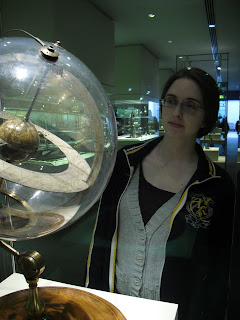03 June 2010
London Museums, Part One: Science, Natural History, and the British Library
London is a museum junkie's paradise: the city is home to nearly a dozen world-class museums . . . and nearly all of them are free! What's more, any one of London's mega-museums is simply too huge to cover in one visit, let alone in one section of a blog post, so what you'll find below are just the highlights. Enjoy!
Science Museum
The Science Museum is one of a cluster of enormous museums on Exhibition Road in South Kensington--it shares a block with the Natural History Museum (see below) and the Victoria and Albert Museum (upcoming post).
For the most part, the Science Museum is a pretty typical sort of "science center," with interactive exhibits on things like physics, astronomy, space travel, and such. For Nana and me, what made the Science Museum unique were its two historical exhibits.
One of these was a large collection of 18th-century scientific equipment, such as the orrery you see above. (An orrery is a device for modeling the motion of the Earth and the solar system.) The collection included many items intended more for display--one might even say performance--than for active experimentation, as one of the great legacies of science in the 18th century was its increasing popularization. In a sense, these items represented the "science museums" of two-and-a-half centuries ago.
The other historical exhibit (too dim for photos, I'm afraid) was on the Golden Age of Islam. During this period, from roughly 750 AD to the Sack of Baghdad in 1258, scholars in the Middle East, North Africa, and Muslim Spain made major contributions to knowledge in general, and especially to science in particular. In fact, many aspects of the scientific method itself can be traced back to these scholars, and their names live on in words such as, for example, "algebra" and "algorithm," just to name a few.
Natural History Museum
The Natural History Museum is famous for two things: architecture and dinosaurs.
Architecture first. The Natural History Museum is sometimes called a "cathedral of nature," and rightfully so, it is housed in a remarkable Victorian behemoth of a space.
The interior is just as impressive as the exterior, with high vaulted ceilings, echoing hallways, and loads of unexpected detail, like the carving below.
Like most of London's museums, the Natural History Museum would take several days to explore fully. We naturally blew right past the geology exhibits . . .
. . . and headed straight for the dinosaurs. As expected, the dinosaur rooms were swarming with giddy schoolchildren, and probably out of consideration for these guests, most of the skeletons on display were reproductions. But all those little smiles disappeared when confronted with the museum's life-sized animatronic T-rex ("life-sized animatronic T-rex" being the coolest phrase you'll read today).
Just. Awesome.
British Library
The British Library in St. Pancras is, first and foremost, a research library--one of the world's greatest, at that. But like most research libraries, they also have a small exhibition space for showing off the collection. Given that, a) I love books, and b) I love maps, the decision to spend an hour at the BL's "Magnificent Maps" exhibit.
I'll spare you a long lecture (maybe Nana the geography teacher will want to chime in with a comment) and just tell you that you can see a couple highlights on the exhibition website, including a fantastic medieval world-map with east at the top and Jerusalem at the center and a fanciful modern map imagining London as a vast urban island. Very cool!
Subscribe to:
Post Comments (Atom)










No comments:
Post a Comment